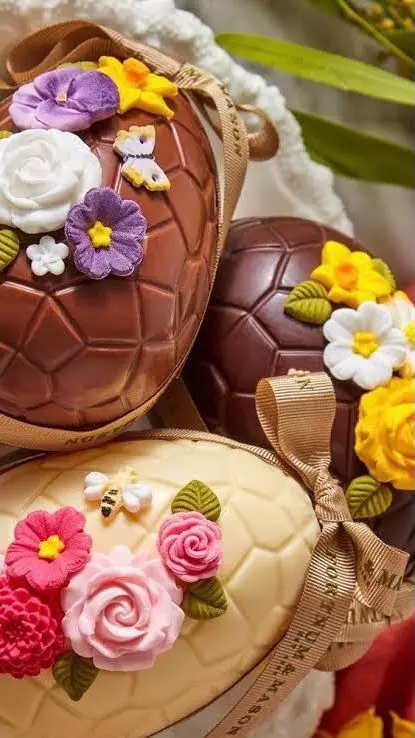Birth, fertility, and more: All you want to know about Easter traditions
Easter eggs represent birth and fertility and are thought to be utilized during Easter festivities to symbolize Jesus' rebirth
By Anoushka Caroline Williams
Hyderabad: Several Easter traditions including hot cross buns and lamb can be traced back to medieval Christian or even earlier pagan beliefs. The chocolate Easter egg, on the other hand, is a more modern take on tradition. It is a relatively new practice that began in the nineteenth century in France and Germany.
Easter is a Christian festival in which people attend worship services, decorate and distribute Easter eggs, and participate in traditional Easter games such as egg rolling, egg tapping, and egg decorating.
Like Father Christmas, who provides gifts to good children, the Easter Bunny brings chocolates to good children.
The now-famous Easter rabbit originated in Germany and was originally mentioned in 17th-century German literature. Apart from solid chocolate eggs, there are several delicacies connected with Easter that differ across the globe, such as Hot Cross Buns, where the cross on these yeast-dough buns filled with raisins represents the cross Christ died on.
Symbolism
Many people believe that Easter eggs represent birth and fertility and are thought to be utilized during Easter festivities to symbolize Jesus' rebirth.
The Easter egg, like the Easter flower (which is used as a church adornment), represents fresh life and fertility.
For ages, chicken eggs have been eaten at Easter. Eggs have traditionally been associated with rebirth and renewal, making them ideal for commemorating both the narrative of Jesus' resurrection and the beginning of spring.
Origin
Although eggs can now be consumed during the Lent fast, they were forbidden during the middle ages, along with meat and dairy. Medieval chefs frequently devised ingenious solutions to this problem, including creating counterfeit eggs to replace them.
For Easter, a time of celebration, eggs, and lamb meat (also a sign of renewal), were reintroduced.
Even after eggs were allowed in fasting meals, they maintained a special position in the Easter feast. John Murrell, a 17th-century cookbook author, advocated "egges with greene sawce," a type of pesto made with sorrel leaves.
On Good Friday, eggs were also given to the local church as a tithe (a sort of yearly rent). This could be where the idea of giving eggs as a gift originated. Several Protestant communities abandoned the practice following the Reformation, although other English villages maintained it alive until the nineteenth century.
Decoration of the eggs
It is unknown when individuals began to adorn Easter eggs, although research has linked it to the 13th century when King Edward I gifted his courtiers gold-leaf-wrapped eggs.
A few centuries later individuals in Europe started dying their egg's distinct colors. They frequently used yellow onion peel or crimson madder roots or beetroots. The red eggs are said to represent Christ's blood. One 17th-century author speculated that this tradition dated back to early Christians in Mesopotamia, although it's difficult to confirm.
The most common way to decorate in England was with petals, which left colorful imprints.
From dyed eggs to chocolate eggs
Although dying and printing eggs is still a popular Easter tradition, eggs are now more typically linked with chocolate. So when did this transformation take place? Chocolate was an intriguing and expensive novelty when it came to Britain in the 17th century.
Chocolate is now considered a solid food. However, it was originally merely a drink that was generally spiced with chili pepper by Aztec and Maya traditions. This fascinating new drink was unlike anything the English had ever tasted. According to one author in those times, it was the "American Nectar": a drink for the gods.
Catholic theologians did associate chocolate with Easter during this period, but they were concerned that drinking chocolate would violate Lent fasting customs. After much deliberation, it was decided that chocolate produced with water might be permissible during fasts and authentic Chocolate was acceptable at Easter, a time of eating and joy.
Chocolate remained prohibitively expensive until 1847, when Fry's (now part of Cadbury) produced the first solid chocolate bars, revolutionizing the chocolate trade.
Chocolate was far more accessible to Victorians, yet it was still considered an indulgence. Fry's developed the first chocolate Easter egg as a luxury treat thirty years later, in 1873, combining the two gift-giving traditions (chocolates and eggs).
Even in the early twentieth century, these chocolate eggs were considered a rare gift, and many individuals never ate the eggs but instead kept them safely.
Only in the 1960s and 1970s did stores begin to offer cheaper chocolate eggs, aiming to benefit from the Easter ritual.
Easter Egg hunt
Chocolate-filled eggs or brightly painted eggs with treats inside are popular Easter gifts. Some choose to loosen their purse strings and spend on the Easter weekend, which follows a 40-day lent period. Non-religious Easter traditions include a treasure hunt-style search for Easter eggs, as well as games like egg rolling and egg decorating.
Did you know that Easter Eggs are hidden messages or pop-culture references in films, video games, and other forms of media? This is because Easter eggs resemble the idea of the Easter egg hunt during the holiday. Hidden messages, characters, or images could be used. It's like a little secret that the software developers or directors want to communicate yet keep private. Looking for these Easter eggs is a fascinating exercise because it usually reveals more about the character or plotline.